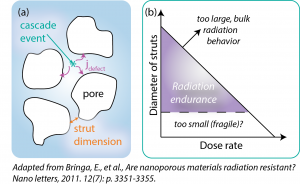 According to the 2010 Department of Energy (DOE) Report to Congress on Nuclear Energy Research and Development Roadmap, nuclear waste management is one of four key challenges to growth of nuclear energy within the US energy portfolio. Developing more robust waste management strategies requires more resilient radiation tolerant materials. For example, existing spent fuel disposal options involve encasing the waste within a nickel alloy cask filled with chemicals designed to absorb moisture and reduce thermal build-up. These materials are subject to high-level irradiation and chemical reactions including corrosion and radiation induced dimensional changes over time, thus reducing the reliability of the containment vessel. One of the most prevalent concepts for improving radiation endurance involves incorporation of a dense network of interfaces within a material to provide suitable sites for defect (vacancies, interstitials, etc.) annihilation. Oxide dispersion strengthened (ODS) steels and metallic nanolaminate structures are two popular examples of interfacial engineering efforts. Recently, nanoporous metallic structures have also been explored for their potential radiation tolerance. In this case, the interface is no longer a grain boundary but rather an interface between the material and a gas. Presumably this pore surface would serve as an infinite defect sink not subject to swelling or thermal mismatch. As illustrated in Figure 1(b), a radiation endurance regime has been identified both theoretically and verified to some degree experimentally. The limits of this regime are bound by the radiation dose rate and the critical ligament/strut dimension within the metallic foam, i.e. the distance defects must diffuse to reach a suitable annihilation site on the surface of a pore, cf. Figure 1(a). Densification of these metallic foams under elevated temperature and radiation accelerated diffusion kinetics poses a significant challenge to this concept. Porous ceramic systems may provide a suitable alternative based on superior thermal stability, sluggish kinetics and high temperature strength. Introduction of porosity of a critical size, necessary to achieve both the desired diffusion distances between sinks but also to reduce the driving forces for densification via capillarity effects, may be the key parameter to fully stabilize such highly engineered microstructures against thermal and radiation damage.
According to the 2010 Department of Energy (DOE) Report to Congress on Nuclear Energy Research and Development Roadmap, nuclear waste management is one of four key challenges to growth of nuclear energy within the US energy portfolio. Developing more robust waste management strategies requires more resilient radiation tolerant materials. For example, existing spent fuel disposal options involve encasing the waste within a nickel alloy cask filled with chemicals designed to absorb moisture and reduce thermal build-up. These materials are subject to high-level irradiation and chemical reactions including corrosion and radiation induced dimensional changes over time, thus reducing the reliability of the containment vessel. One of the most prevalent concepts for improving radiation endurance involves incorporation of a dense network of interfaces within a material to provide suitable sites for defect (vacancies, interstitials, etc.) annihilation. Oxide dispersion strengthened (ODS) steels and metallic nanolaminate structures are two popular examples of interfacial engineering efforts. Recently, nanoporous metallic structures have also been explored for their potential radiation tolerance. In this case, the interface is no longer a grain boundary but rather an interface between the material and a gas. Presumably this pore surface would serve as an infinite defect sink not subject to swelling or thermal mismatch. As illustrated in Figure 1(b), a radiation endurance regime has been identified both theoretically and verified to some degree experimentally. The limits of this regime are bound by the radiation dose rate and the critical ligament/strut dimension within the metallic foam, i.e. the distance defects must diffuse to reach a suitable annihilation site on the surface of a pore, cf. Figure 1(a). Densification of these metallic foams under elevated temperature and radiation accelerated diffusion kinetics poses a significant challenge to this concept. Porous ceramic systems may provide a suitable alternative based on superior thermal stability, sluggish kinetics and high temperature strength. Introduction of porosity of a critical size, necessary to achieve both the desired diffusion distances between sinks but also to reduce the driving forces for densification via capillarity effects, may be the key parameter to fully stabilize such highly engineered microstructures against thermal and radiation damage.
Relevant publications:
- Krogstad, J.A. “Is there room for porosity in nuclear ceramics? What we can learn from dynamic microstructures in extreme conditions.” Ceram. Bull. 96 (2017) 30-34. Link.